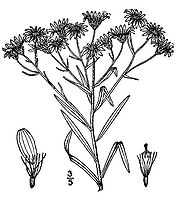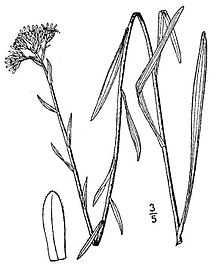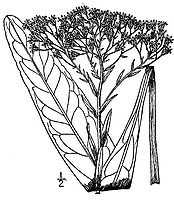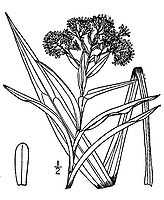Oligoneuron
| Oligoneuron | |
|---|---|
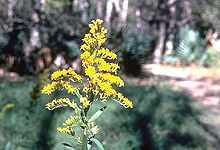 | |
| Stiff Goldenrod (Oligoneuron rigidum var. rigidum) | |
| Scientific classification | |
| Kingdom: | Plantae |
| (unranked): | Angiosperms |
| (unranked): | Eudicots |
| (unranked): | Asterids |
| Order: | Asterales |
| Family: | Asteraceae |
| Tribe: | Astereae |
| Genus: | Oligoneuron Small |
| Species | |
|
See text. | |
Oligoneuron is a small genus of flowering plants in the sunflower family (Asteraceae).
This genus was previously treated as a section in the genus Solidago or belonged to the genus Aster. The genus Oligoneuron is considered phylogenetically a basal or near-basal member of the subtribe Astereae. A 2006 taxonomy by Semple and Cook treats it as part of Solidago.[1]
These are herbaceous, perennial North American plants, growing on wet prairies, open fields, ditches and dry woods, roadsides, and on dry, calcareous cliffs and ledges.
The leafy stem grows 50-100 cm tall and is unbranched, except near the inflorescence. The stem is covered with fine white hairs, and grows from deep fibrous roots.
The light green, simple leaves are linear-lanceolate, with smooth or slightly serrated margins. The basal leaves are longer (about 25 cm long) and may be oblong and longitudinally folded. Some may persist through the winter. The smaller leaves alternate upwards and are stalkless They become stiffer and rough textured later in the year.
The broad, flat-topped inflorescence is a dense, apical corymb of 20-30 bright yellow flower heads (5-15 cm across), more or less bunched together. The 7-9 ray florets are very small (0.6-1.2 cm across). These flowers have a mild fragrance.
The fruit is an achene with small tufts of white or light brown hair. They are distributed by the wind.
Most are hard and bitter species, but Stiff Goldenrod is more palatable for grazing livestock.
Most species are very common but some are threatened such as O. houghtonii.
Species
- Oligoneuron album (Nutt.) G.L.Nesom. : White Upland Goldenrod, Prairie Goldenrod. (Solidago ptarmicoides[1])
- Oligoneuron houghtonii : Houghton’s Goldenrod
- Oligoneuron nitidum (Torr. & A. Gray) Small : Shiny Goldenrod
- Oligoneuron ohioense (Frank ex Riddell) G.N. Jones : Ohio Goldenrod
- Oligoneuron riddellii Frank ex Riddell) Rydb. : Riddell’s Goldenrod
- Oligoneuron rigidum (L.)Small Stiff Goldenrod
- Oligoneuron rigidum var. glabratum
- Oligoneuron rigidum var. humilis
- Oligoneuron rigidum var. rigidum
Natural hybrids
- Oligoneuron × bernardii
- Oligoneuron × krotkovii
- Oligoneuron × lutescens
- Oligoneuron × maheuxii
One hypothesis about the origin of the garden plant x Solidaster is that it was an intergeneric hybrid between Oligoneuron album and Euthamia graminifolia. However, molecular evidence points to Oligoneuron album being more accurately placed in Solidago (as Solidago ptarmicoides), and the other parent as being Solidago canadensis.[1]
Illustration gallery
|
References
- ↑ 1.0 1.1 1.2 Schilling, E.E., J.B. Beck, P.J. Calie, and R.L. Small (2008), "Molecular analysis of Solidaster cv. Lemore, a hybrid goldenrod (Asteraceae)", Journal Botanical Research Institute of Texas 2: 7–18
- Kapoor, B.M. and J.R. Beaudry. 1966. Studies on Solidago VII, The taxonomic status of the taxa Brachchaeta, Brintonia, Chrysoma, Euthamia, Oligoneuron and Petradoria in relation to Solidago; Canad. J. Genet. Cytol, 8:422-433.
- Anderson, L.C.; Creech, J.B. - Comparative leaf anatomy of Solidago and related Asteraceae ; American Journal of Botany 62 (5), 1975, p 486-493 (concerning Oligoneuron album).
- Nesom, G. L. 1993. Taxonomic infrastructure of Solidago and Oligoneuron (Asteraceae: Astereae) and observations on their phylogenetic position. Phytologia 75(1):1-44.
